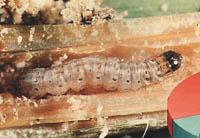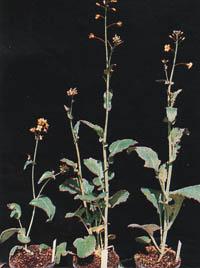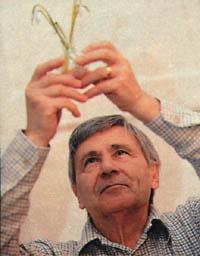Transgenesis: the latest invention of biotechnology
1999/10/01 Imaz Amiano, Eneko - Elhuyar Zientziaren Komunikazioa Iturria: Elhuyar aldizkaria
What are GMOs? The DNA of another species (one or few genes), i.e. plants or animals that contain genetic matter and are breeders (e.g., plants with fish genes). Transgenic foods will, however, be foods derived from them.

However, some prefer to talk about genetically modified organisms (GMOs or GMOs) than GMOs, either because they consider it more direct or to avoid the poor social reputation of the transgenic term. In this case gene transformation can be part of the same species, so the GMO concept is broader than the concept of transgenic. Often both are used confusing. When talking about food, transgenic or genetically modified food (GM) is used.
Genetic engineering is used to obtain the desired result. So far we have worked mainly with plants and, at the same time, this article will talk about transgenic plants. We talk about food derived from plants.
More and more transgenic foods
The presence of genetically modified plants (GMOs) is increasing. Around 3 million hectares have been planted worldwide in 1996. The following year were 13 million and in 1998, the area of fields planted with GM plants exceeded 30 million hectares, of which 25 million were in the United States worldwide. Large agrochemical companies have opted for this and ensure that the growth of these crops is a consequence of the profitability offered to the farmer the new seeds. In 1997, the Swiss Novartis invested 16% of the budget of the agricultural research and development department, 12,227.8 million pesetas/482.17 million pounds in seeds. His US rival, Monsanto, invested $450 million (64,214.15 million pesetas/2,532.10 million pounds) in biotechnology research in 1996.
Currently, the most cultivated GM plant is sober. It is also the first crop to be genetically manipulated. Then the most cultivated corn is starch and animal feed. The planting of cotton, rape, tobacco, tomato and transgenic vegetables has decreased to date.
50 GMO authorized for marketing in the US. In the European Association, however, the harvest of 11 modified products, three animal disease vaccines, a milk antibiotic detection kit and two ornamental plants are allowed to market. The rest can only be sown for testing, except in the Spanish state, where the variety of Bt corn can be sown and sold.

Why GE food?
After changing the genetic content of plants, the plants obtained, their fruits and the foods made with them are ready for marketing. But what is the goal of this transformation? What benefits do they offer?
At first certain characteristics can be introduced to the transgenic plant. For example:
- Resistance to certain products, mainly herbicides or insecticides.
- The ability of the plants themselves to produce various products, especially herbicides or insecticides.
- Delay the ripening of the fruits or ripen all the fruits at the same time.
- Obtaining plants with heads that do not fall so easily the grains, such as a wheat plant with a head that does not fall so easily wheat grains.
- Resistance to cold, salt, etc. For example, with the genes of the plant Craterostigma plantigenium have created plants that after droughts are “resurrected”.
All of them are needed to increase the agricultural value of plants. However, the former are the most exploited today. They are also being investigated to increase tolerance to outdoor conditions, but that is more difficult because it depends on several genes.
Studies with genes have also been conducted to reinforce the characteristics of ornamental plants (color, size, smell, etc. ).
The advantages of agrochemical companies include pest protection and the reduction of the use of herbicides and insecticides. Thus, with fewer chemicals, land and the environment would have more health.
Although the research lines developed so far for agriculture are diverse, one of the best known is GE corn, Bt corn produced by several houses. Corn has the disease of the lepidopter called a drill. In larval phase, the caterpillar of the taladrine inhabits the interior of the corn plant, drilling and eating its stem, leaves and mazorcas, thus reducing its production. Bacillus thuringiensis, however, is a bacillus that appears in nature and contains in its components a protein that taladrine cannot digest. Knowing this, the gene that encodes this protein from genetic engineering (hence the name "Bt corn") has been introduced into maize plants and it is the plant itself that produces the indigent protein for taladrine. Consequently, by eating the taladrine the corn plant, the protein damages and perforates your digestive system and, of course, the taladrine thread dies. This Bt protein was sprayed as an insecticide before developing the technique of GMOs. In the case of cotton, Bt protein has also been used to create GE varieties, since Bt protein can be used as an insecticide in the fight against several lepidoptera.

In other cases, such as tomato, a gene has been included that prevents the production of proteins that cause the ripening of the fruits. Or in the case of beet, they are introduced a gene that protects plants against herbicides, and thus can also be used after beet planting to remove herbicide weeds.
These three examples are the most widely treated uses in the field of GMOs and the uses that are generating the most controversy. But there are other lines of research more related to animals and medicine. For example, transgenic cows, sheep or goats that emit milk with insulin, vitamins or specific medicines among their ingredients, transgenic plants with vaccines inside. Or use transgenic plants as bioreactors to achieve an inexpensive production of economically important proteins or metabolites. Or as a research tool for the action of genes in biological processes, etc. However, these types of uses do not have the same development as the previous ones and have generated less debate.
Types of food GE
Genetically modified foods can be classified into three groups:
- Primary foods: GM foods directly, without any transformation, when they are food. These foods will include manipulated genes and resulting proteins (e.g. transgenic crossed tomato).
- Processed foods of three types: when food is a GM food that has been transformed (e.g. corn flour), foods that the above have as ingredients (e.g. margarine made from transgenic corn) and food with additives obtained from an GE food (e.g. when the cheese making quimosine comes from a fungus that has been manipulated). This second type of food can be divided into two groups: 2.1.- Those in which there are no elements derived from genetic transformation, i.e. genes or proteins (e.g. 99% of oils are composed of triglycerides and contain hardly any genes or proteins, although the original plant, such as rape, is transgenic). 2.2.- Presence of transformed genes and/or proteins (e.g. hydrolyzed proteins, components of many foods such as emulsifiers, flavorings...)
- Foods derived from fermentation: are those derived from the use of bacteria or yeast that have undergone genetic transformation (e.g. wine, cheese...).
Transgenic: yes, no; yes, but... Prospects for and against
The creation of genetically modified organisms has generated numerous and harsh debates for various reasons.
In the opinion of supporters, all new things cause fear, but there is no reason for it. According to them, man has spent time using biotechnology, creating new varieties and hybrids. Agrochemical companies, as mentioned above, reduce the use of chemicals, improve the adaptation of crops to the environment, increase the production and competitiveness of farmers, etc. the aforementioned. Some have also mentioned the improvement of human food quality and the reduction of famines. There is also the use of GMOs in the research and production of other products (vitamins, proteins, etc. ).

Various aspects are mentioned in the debate. For example, there are people who are allergic to certain foods and who are now believed to increase cases of allergies in case of change of genes of different species. For example, if someone has a soy allergy, they know they can't eat food that contains it, but they do. However, if the transgenic tomato contains soy genes, it would risk developing an allergic reaction if you did not know it and if the tomato has been introduced a gene (protein after all) that makes you allergic.
These types of cases can be solved with appropriate labels.
However, those who show a critical attitude towards GM products consider even more serious the use of antibiotics in genetically modified organisms. As discussed above, to know if the desired gene has been inserted into the plant markers are used, many of which have so far been antibiotic resistance genes. That is, not all cells that have been cultivated always include foreign genes and to avoid them, the antibiotic is added to the culture after gene transfer. Thus, cells that have not internalized the new gene, along with the marker, will die and GMOs will survive. And that is one of the keys to the debate on GMOs, as many believe that this resistance can extend to microorganisms, wild or domesticated animals, plants or human beings. Four are the most commonly used antibiotics so far to mark:
- Ampicillin. The most widely used antibiotic family internationally and already used in Bt Novartis corn on the market in several states. They say that pathogens that develop ampicillin resistance become resistant to many types of penicillin with a single mutation of this gene. Arguing the importance of the use of ampicillin in medicine, in France it is forbidden to plant and commercialize the corn that carries this antibiotic.
- Canamycin and neomycin. Still quite used in poor countries. Canamycin is very toxic but useful when there is no other alternative. The resistance gene to this antibiotic is introduced in slow-maturing Calgene tomatoes and Bt rapeseed by AgrEvo and Calgen.
- Streptomycin and sectinomycin. The former continues to have widespread use in medicine. It can be found in Bt cotton by Monasnt.
- Mikazine. The World Health Organization considered a reserve antibiotic and recommended the least use of medicine to prevent resistance. There are increasing difficulties to combat certain diseases and bacteria due to the proliferation of resistance. A Dutch company decided to enter a variety of potatoes, although finally this potato was removed from the list of GM foods pending approval in Europe.
Patrice Courvalin, head of bacterial agent research at the Institut Pasteur in Paris, announced that antibiotic resistance is occurring. Bacteria have developed very efficient DNA emission systems. "The transfer takes place in various ways. Through these systems, bacteria exchange antibiotic resistance genes.”
On the other hand, since the genes introduced in transgenic plants are constituted by vector fragments, there are theoretically possibilities of DNA exchange. In this regard, it is worth noting the research carried out by Robert Havenaire at the Zeist Food Research and Nutrition Institute in Holland. In fact, proponents of transgenic technologies claim that genetic material is rapidly dissolved in the digestive tract, but the study has shown that it takes about 6 minutes without degrading in the large intestine. Therefore, it would be able to transform the cells of the environment. An artificial digestive system with the same microorganisms and enzymes that can be found in the real ones was built for the test. It introduced bacteria with antibiotic resistance genes, obtaining the aforementioned result. If these bacteria were like those found in the intestine, that is, Enterococcus, these researchers claim that it would be possible to pass a resistance gene to a local bacteria of the intestine of 1 per 10 million. At the moment, with the use of Lactobacillus bacteria (usually not present in the intestine) no transfer to the intestinal flora or with the transgenic tomato Flavr Savr has been observed.
However, agrochemical companies claim that antibiotic resistance is already widespread, so the damage would not be so much. In addition, they consider that it would be very difficult for a gene transfer to intestinal microorganisms or epithelial cells, since in addition to resistance genes, the intestine enters many other DNA, thus decreasing the probability. And if there were any transfer, the epithelial cells themselves would see that those genes are foreign and destroy them. However, they say that although the genes were introduced and expressed in the cell, it would not affect the organism, since the survival of intestinal cells is very short, that is, that new and untransformed cells would replace them immediately. They have also observed that there is no mechanism for transferring these genes to intestinal microorganisms.
However, there are also studies that show the existence of a gene transfer between living beings outside the intestine, such as the appearance of plant modified genes in local microorganisms 130 days after their release to the soil. Faced with this, the most optimistic about GMOs speak of an experiment with the bacteria E. coli. It installed maize cells with anpiziline resistance genes in an E. coli breeding to see if there was transfer. The transfer was 1 in 6.8 x 1019, so it is not significant. They also consider that this is even more difficult in the natural environment. However, some researchers claim that in the natural environment things happen very differently and that the system is much more complex.
Experts also mention pleiotropic effects. That is, not knowing where this new gene has stuck by adding new genes to organisms. This is common and can affect genes that encode toxins or encode proteins that are food.

Other risks include resistance to herbicides incorporated into crops or genes introduced by crops themselves for insecticide production. Given the possible transfer of genes between different living beings, some people think that they could spread in nature and form plants or "weeds" and insects resistant to both herbicides and insecticides. If this happens, there would be a situation contrary to the desired one.
Another factor to consider in the transfer of herbicide resistance genes is herbicide. In fact, the "ancestors" of many crops that are exploited still remain in nature, and being close relatives it is usually quite common that among them there is pollen transfer. Anne-Marie Chève's team from the plant improvement area of the National Institute of Agronomic Research of France (AIIN) has analyzed, among others, the crosses between the transgenic rapeseed or oleous arbi (resistant to the herbicide called Basta) and the non-transgenic rapeseed or the basalandars of the same family located in nearby lands. In this case, a kilometer and a half of the spring have found pollen and, although transgenic reflexes and rape can be hybridized at the same time, they have not found any type of reflexes resistant to Baste. On the contrary, Thomas Mikkelsen et al., from the Riso national laboratory in Roskilde, Denmark, have discovered genes of resistance to Vota in relatives of arbi, typical of Denmark, which is only located in two generations. In addition, transgenic wild plants are inseparable from originals and virtually all pollen seeds are viable.
Continuing with pollen, an article has published that monarch butterfly caterpillars, after eating with broken Bt corn pulley leaves, eat less, grow more slowly and have a higher mortality rate.
In addition, as pollen expansion is uncontrollable, users of organic farming may have problems with hybrid generation.
But also, Arpad Pusztai, a former researcher at the Rowett Research Institute in Aberdeen, suggested that GE foods themselves could be directly harmful. In his research he fed two groups of rats with potatoes, some of them provided common potatoes enriched with lectin and those of the second group genetically modified potatoes for the production of lectin. It is an insecticide protein extracted from the plant called Lektina Galanthus nivalis. Rats who ate transgenic potatoes had slower growth, liver, brain and organ development problems needed to live and worrying deficiencies in the immune system. Those who ate as a supplementary lectin did not suffer damage. Two days after its publication, Pusztai was fired on charges of scientific fraud. He ruled that a commission would later disappoint, but the commission considered that the results were not statistically significant.
If we look at the examples we will find results in favor and against, but it seems that the results are not as good as in the beginning said large companies, since not all factors are controlled. Sometimes more chemicals have to be used than expected or the increase in harvest has been lower than expected. But at the moment it does not seem that the predictions of the most catastrophic counterparts are being fulfilled. Despite discussions held last February, representatives from more than 170 countries gathered in Cartagena were also not able to sign a common protocol on GMOs. On the other hand, he pointed out that numerous food companies and large distributors will not use genetically modified products, mainly due to the social confusion generated.
As for the Basque Country, at the moment only genetically modified seeds have been planted in Navarre, which in 1998 have been 180 hectares of corn (about 10% of the total). In the Autonomous Community of the Basque Country there is a moratorium of five years in force and in the north they are governed by French regulations, so despite the abundance of test fields in that State, crops for the market cannot be planted. In the Spanish state you can plant and market corn, as well as import soy but not sow. However, the sale and import of genetically modified products approved in Europe is permitted throughout the territory.
As far as the European Union is concerned, authorization for the planting of new GM food products has been denied since 24 June, but maize and soybeans can be planted, imported and marketed until then accepted.

Gai honi buruzko eduki gehiago
Elhuyarrek garatutako teknologia





